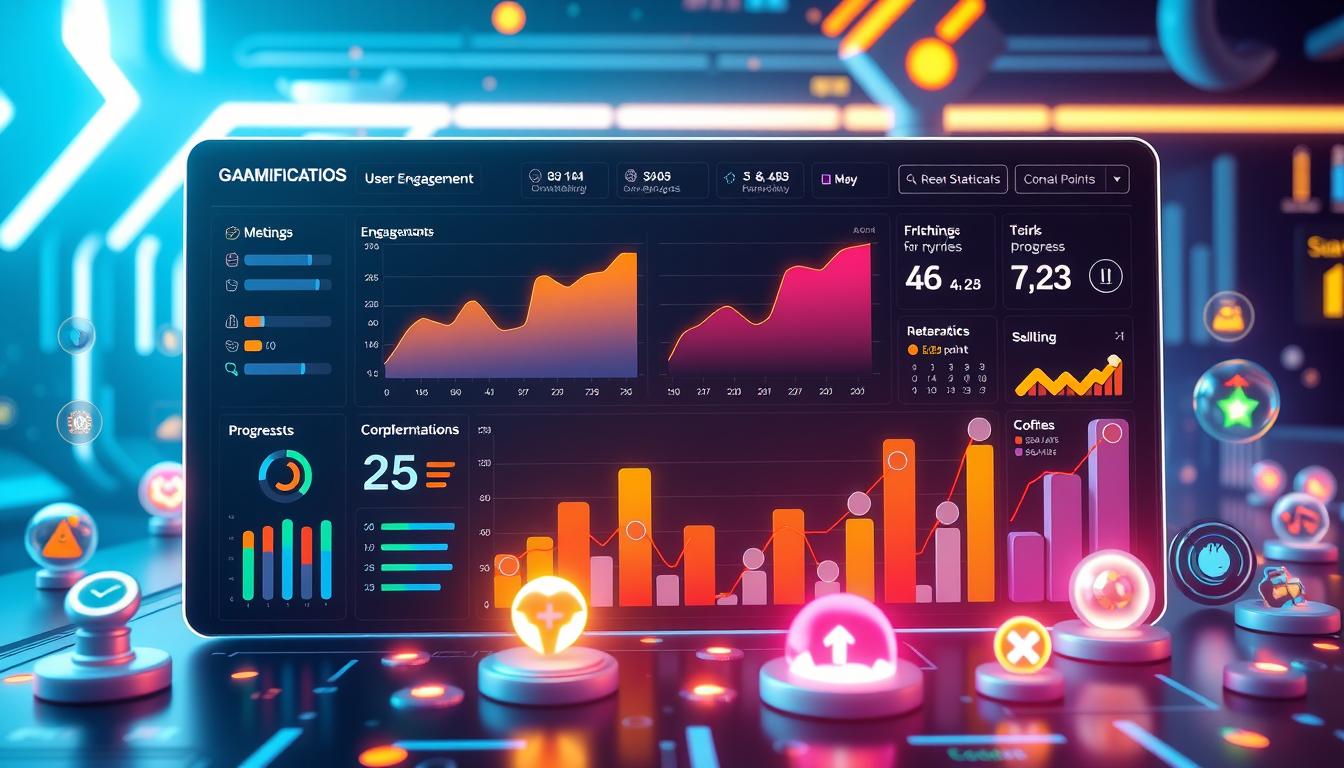Expos are evolving, and gamification metrics are leading the charge. By integrating fun elements into events, organizers can boost engagement and create memorable experiences. But how do we know if these strategies are working? That’s where event engagement analytics come in.
Measuring the impact of gamified strategies at expos is crucial for success. It’s not just about having fun; it’s about driving results. With the right tools and techniques, you can track performance, optimize your approach, and prove the value of your gamification efforts.
Key Takeaways
- Gamification metrics are essential for evaluating expo success
- Event engagement analytics provide insights into attendee behavior
- Measuring impact helps optimize future gamified strategies
- The right tools can track performance and prove ROI
- Data-driven decisions lead to more effective expo experiences
Understanding Gamification Metrics Fundamentals
Gamification has revolutionized expo strategies, making it crucial to measure success accurately. By understanding key metrics, you can optimize your approach and boost customer retention at expos. Let’s explore the essentials of gamification metrics to enhance your expo performance.
Key Performance Indicators (KPIs) for Gamified Systems
Effective KPIs are vital for tracking expo attendee interactions. Some important metrics include:
- Participation rate
- Completion rate
- Average time spent
- Points earned per user
- Social shares
Baseline Metrics Establishment
To gauge improvement, set baseline metrics before implementing gamification. Compare pre and post-gamification data to measure impact on lead generation tracking and overall engagement.
Data Collection Methods and Tools
Utilize various tools to gather accurate data on expo attendee interactions:
- Mobile apps
- RFID technology
- QR codes
- Surveys
Implementing these methods helps streamline lead generation tracking and provides valuable insights into attendee behavior. By leveraging efficient event management tools, you can optimize your gamified expo strategy for maximum impact.
How to Measure the Success of Your Gamified Expo Strategy
Measuring the success of your gamified expo strategy is crucial for optimizing future events and maximizing ROI. By tracking key metrics, you can gauge the effectiveness of your approach and make data-driven decisions to improve performance.
Start by setting clear objectives for your gamified elements. These might include increasing booth visits, enhancing brand awareness, or boosting lead generation. Once you’ve established your goals, you can focus on relevant metrics to assess your strategy’s impact.
One essential metric to track is sales conversion rates. Monitor how many expo attendees who engaged with your gamified elements ultimately became customers. This data helps you understand the effectiveness of your audience and tailor your approach accordingly.
Sponsor ROI measurement is another critical aspect of evaluating your gamified expo strategy. Calculate the return on investment for each sponsor by comparing their contributions to the value generated through increased brand exposure, leads acquired, and direct sales.
“Gamification isn’t just about fun; it’s about driving measurable results that contribute to your bottom line.”
To get a comprehensive view of your strategy’s success, consider the following metrics:
- Participant engagement rates
- Average time spent at your booth
- Social media mentions and shares
- Number of qualified leads generated
- Post-event survey feedback
| Metric | Importance | Measurement Method |
|---|---|---|
| Sales Conversion Rates | High | Track attendees from game participation to purchase |
| Sponsor ROI | High | Compare sponsor investment to value generated |
| Engagement Rates | Medium | Monitor participation in gamified activities |
| Lead Quality | High | Assess lead scores and follow-up conversion rates |
By consistently analyzing these metrics, you’ll gain valuable insights into the effectiveness of your gamified expo strategy and identify areas for improvement in future events.
Essential Engagement Analytics Tools and Platforms
Tracking event engagement analytics is crucial for measuring the success of your gamified expo strategy. The right tools can provide valuable insights into brand awareness impact and participant behavior. Let’s explore some essential platforms that can help you optimize your expo experience.
Real-time Monitoring Solutions
Real-time monitoring tools offer instant feedback on attendee engagement. These platforms track interactions, participation rates, and even emotional responses. By analyzing this data, you can make quick adjustments to improve the overall expo experience.
Data Visualization Platforms
Visualizing complex data sets helps in understanding patterns and trends. Platforms like Tableau and Power BI transform raw event engagement analytics into easy-to-understand charts and graphs. This visual representation makes it simpler to identify areas of success and opportunities for improvement in your gamified strategy.
Analytics Integration Methods
Integrating various analytics tools provides a comprehensive view of your expo’s performance. By connecting different data sources, you can gain deeper insights into attendee behavior, lead generation, and overall brand awareness impact. This holistic approach ensures no valuable information slips through the cracks.
Remember, the key to successful event engagement analytics is not just collecting data, but interpreting it effectively to drive meaningful improvements in your gamified expo strategy.
Tracking User Participation and Interaction Rates
Measuring expo attendee interactions is crucial for gauging the success of your gamified strategy. By tracking user participation, you gain valuable insights into how well your gamification elements resonate with attendees. This data helps refine future expo experiences and boost engagement.
![]()
- Number of active users
- Time spent engaging with gamified elements
- Completion rates for challenges or quests
- Social shares and referrals generated
Implementing a robust tracking system allows you to capture these vital gamification metrics. Consider using analytics tools that provide real-time data on user behavior and interactions.
“Tracking user participation is not just about numbers; it’s about understanding attendee behavior and preferences to create more engaging expo experiences.”
To visualize the impact of your gamified strategy, analyze the following interaction rates:
| Interaction Type | Average Rate | Target Rate |
|---|---|---|
| Badge Earnings | 45% | 60% |
| Challenge Completions | 30% | 50% |
| Leaderboard Engagement | 25% | 40% |
| Social Shares | 15% | 25% |
By comparing actual rates to target rates, you can identify areas for improvement and set realistic goals for future expos. Remember, the key to successful gamification lies in continuous refinement based on attendee feedback and interaction data.
Measuring ROI Through Gamification Metrics
Gamification at expos can boost engagement, but how do we measure its true value? Let’s explore ways to calculate the return on investment for these interactive strategies.
Financial Impact Assessment
To gauge the financial impact of gamified expo strategies, track sponsor ROI measurement and sales conversion rates. Compare pre and post-gamification figures to see the difference in lead quality and quantity. This data helps justify the investment to stakeholders and guides future budget allocation.
Cost-Benefit Analysis Framework
Create a framework that weighs the costs of implementing gamification against its benefits. Include expenses like software development, hardware, and staff training. On the benefit side, factor in increased leads, higher engagement rates, and improved brand visibility. This analysis provides a clear picture of the strategy’s effectiveness.
Long-term Value Calculation
Don’t just focus on immediate gains. Calculate the long-term value of your gamification efforts by considering:
- Customer lifetime value increase
- Brand loyalty improvements
- Word-of-mouth marketing generated
- Recurring attendance at future expos
By measuring these long-term metrics, you’ll get a comprehensive view of your gamification ROI, ensuring your strategies pay off well into the future.
Social Media Impact and Brand Awareness Metrics

Gamified expo strategies can supercharge your brand’s online presence. To gauge their effectiveness, you need to dive into social media impact and brand awareness metrics. These insights help fine-tune your approach and maximize your reach.
Social media buzz monitoring is key to understanding your strategy’s performance. Track mentions, hashtags, and engagement rates across platforms. This data paints a picture of how well your gamified elements resonate with attendees and their networks.
Brand awareness impact goes beyond mere numbers. It’s about the quality of interactions and the sentiment behind them. Use sentiment analysis tools to gauge the tone of conversations about your brand. Positive chatter can indicate a successful gamification strategy.
| Metric | Importance | Tool |
|---|---|---|
| Mention Volume | Indicates reach | Hootsuite |
| Engagement Rate | Shows interaction level | Sprout Social |
| Sentiment Score | Reflects brand perception | Brandwatch |
Don’t forget to measure share of voice. This metric compares your brand’s presence to competitors. A rising share of voice suggests your gamified strategy is capturing more attention and potentially generating.
Remember, metrics are just the start. Use these insights to refine your gamification approach and create even more engaging expo experiences.
Lead Generation and Conversion Tracking Systems
Tracking leads and conversions is crucial for measuring the success of your gamified expo strategy. Effective lead generation tracking helps you understand how well your gamification efforts are performing and where improvements can be made.
Pipeline Development Metrics
To gauge the effectiveness of your lead generation efforts, focus on these key pipeline metrics:
- Number of new leads generated
- Lead quality score
- Time to qualification
- Conversion rate by funnel stage
These metrics provide insights into your pipeline’s health and help identify bottlenecks in your lead nurturing process.
Conversion Rate Optimization
Improving sales conversion rates is an ongoing process. Implement A/B testing for your gamified elements to determine which versions drive higher engagement and conversions. Analyze user behavior data to identify drop-off points and optimize accordingly.
Quality Score Assessment
Evaluate lead quality using a scoring system based on factors like:
- Engagement level with gamified elements
- Demographic fit
- Company size and industry
- Budget and timeline
This assessment helps prioritize high-potential leads and allocate resources effectively, maximizing your ROI from gamification efforts.
Analyzing Player Behavior and Performance Patterns
Understanding how players interact with your gamified expo is key to success. By tracking expo attendee interactions, you can spot trends and improve your strategy. Look at which games or challenges draw the most attention. This insight helps you create better experiences in the future.
Gamification metrics go beyond simple numbers. They show you what motivates your attendees. Do they prefer quick, easy tasks or longer, more complex challenges? Use this data to tailor your approach. It’s like creating eye-catching landing pages – you need to know what grabs your audience’s attention.
Don’t forget to look at how players progress over time. Are they getting better at your games? Do they engage more as the expo goes on? These patterns can show you if your gamification is working as intended. Use this info to tweak your setup, making it more fun and rewarding for everyone involved.
Remember, the goal is to make your expo both enjoyable and effective. By analyzing player behavior, you can strike that perfect balance. Keep refining your approach based on what you learn. This way, each expo becomes better than the last, driving more engagement and success for your brand.






